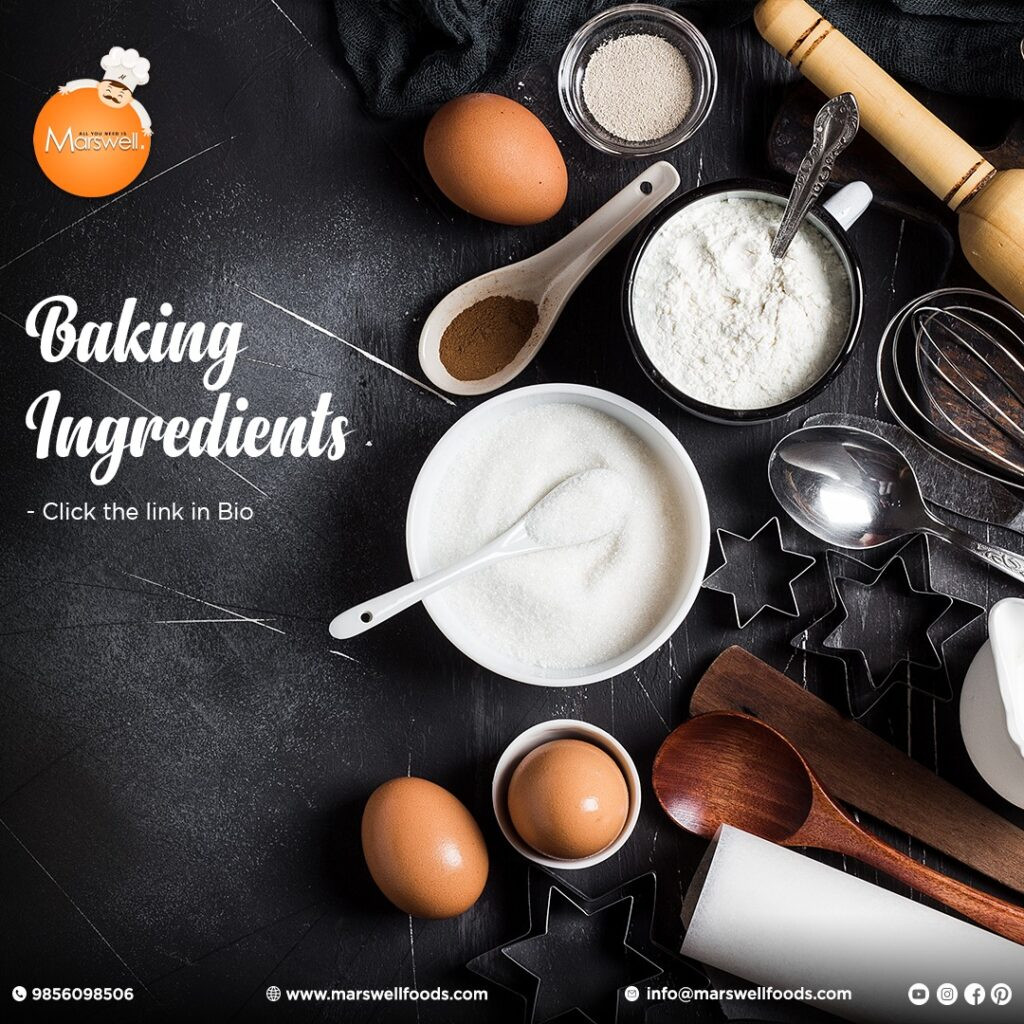
Baking Ingredients ! Marswellfoods

2022, Jan-18 · 8 min read
Baking Ingredients
Baking is something that most of us enjoy doing, whether it’s watching someone else do it or getting our hands dirty in the kitchen. To get started, we’ll need some basic items on hand, even for the simplest of recipes, so here’s a list to get you started.
A well-stocked commercial kitchen is essential for high-quality, professional baking. To make everything from muffins and cupcakes to multi-tiered cakes and delectable cookies, bakers require vast quantities of a few key components. If you own or are planning to open a bakery and want to know what ingredients to keep on hand at all times.
Baking is the process of cooking with dry heat, usually in an oven. It is the oldest way of cooking. Baking Ingredients includes such as bread, rolls, cookies, pies, pastries, and muffins, are typically made up of flour or meal extracted from grains. Bread, which was already a regular staple in prehistoric times, is a good and rich source of nutrition for humans.
Here is the list of Baking Ingredients you need during different stages of baking process.
All Purpose Flour & Other Flours
Flour, often known as all-purpose flour and maida in India, is at the heart of most baking recipes. In kirana stores and supermarkets, it’s sold in branded packets and by the kilo. Maida is prepared by skimming the bran and husk from wheat flour, removing the fibre content and leaving a fine, smooth flour behind. Because maida is such a crucial element in any recipe, it must be of high quality. Maida/all-purpose flour is sometimes confused with self-rising flour. While maida is simply flour, self-rising flour is combined with raising agents such as baking powder and a pinch of salt.
Butter
Butter is what brings it all together, adding richness and texture to our soft, buttery, flaky bakes, be they cakes or pastries like shortcrust pastries. The best butter to use is store-bought butter, such as Amul butter or President butter. Although unsalted butter is preferred for baking, using salted butter isn’t a bad idea. When added to the dish, the salt in the butter brings out the flavours brilliantly.
Oil
Many times, oil is used for butter in recipes to replace the fat content. Oil is utilized in cakes and sponges that are light due to the eggs in them and don’t want to be dragged down by the butter’s heaviness.
Castor Sugar
When paired with butter or eggs, superfine processed sugar, which has finer granules, works nicely. When compared to conventional sugar crystals, which don’t melt quickly and spoil the recipe’s composition, the superfine texture helps you get the right texture required for the recipe.
Brown Sugar
Brown sugar is made out of less refined sugar crystals that still have a covering of dark molasses on them. It’s best utilized in tea cakes and cookies, which have an earthy, rustic flavour and texture thanks to the brown sugar.
Icing Sugar
Icing sugar is a combination of powdered sugar and cornflour. Confectioners’ sugar is another name for it. Sugar and icing sugar are frequently confused and cannot usually be used interchangeably. Icing sugar is commonly used in cookies to add to the texture of a crispy-crunchy cookie. It is also used in butter creams to assist give the icing a good body.
Cocoa Powder
Cocoa powder is a by-product of extracting all of the important ingredients of a cacao bean. It is the pod’s final extract. Although cocoa powder has a bitter taste, it adds flavour and colour to the baked goods. The only difference between light and dark cocoa powder is the hue of the cocoa. Use it according to the recipe you’re making and the end effect you want. Good brands to use are Hershey’s and Cadbury’s.
Leavening Agents (Baking Powder and Baking Soda)
Baking soda and baking powder are both leavening agents, but although baking soda is merely baking soda, baking powder also contains baking soda and cream of tartar. They each have a distinct purpose and are utilised in different ways in different recipes.
Salt
Salt is used in baking recipes to bring out the flavours of the other ingredients. In cake batters or cookie doughs, salt helps to balance the sweetness. In sweet baked goods, only a pinch will suffice. Salt is used in breads and savoury bakes not just for flavour, but also to help control the rate at which yeast multiplies when coupled with flour in a recipe.
Flavouring Agents
In baking, a variety of flavouring agents are employed, including Vanilla Essence, which is the most popular, and Extract, which is often a pure extract from the fresh item. Fresh lemon zest or orange zest are two other flavouring options. Cinnamon, star anise, and nutmeg, to name a few, add a wonderful aroma to the dish.
Follow us on Social Media for more interesting updates
Youtube
Facebook
Instagram